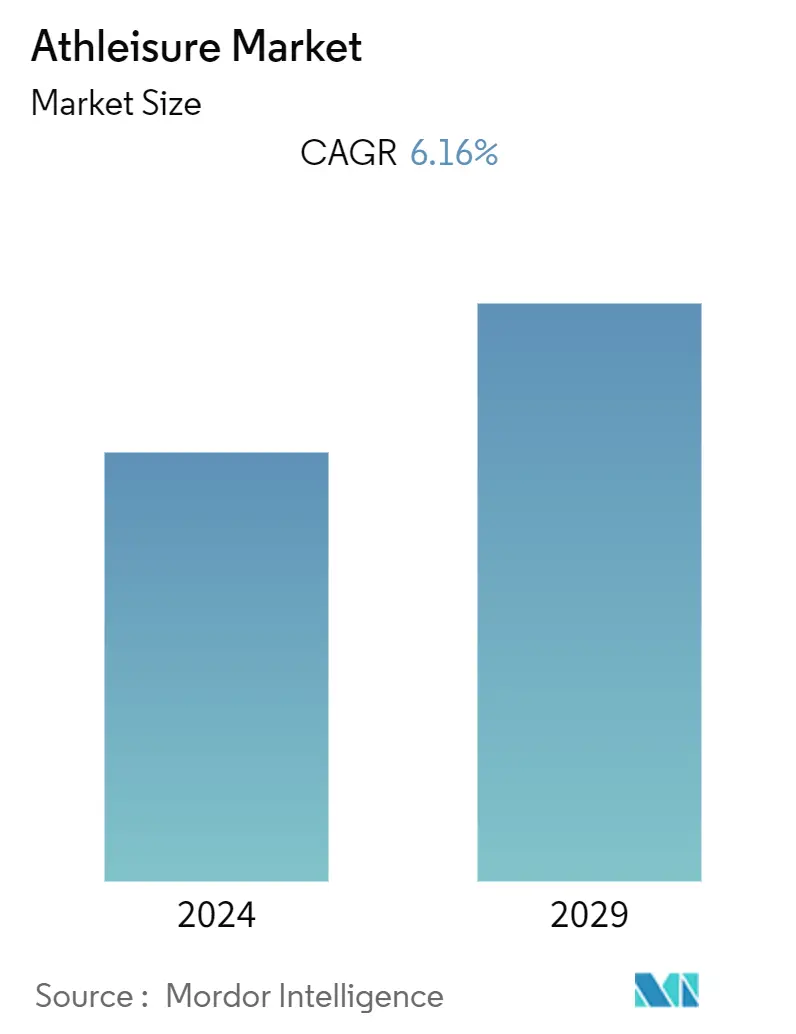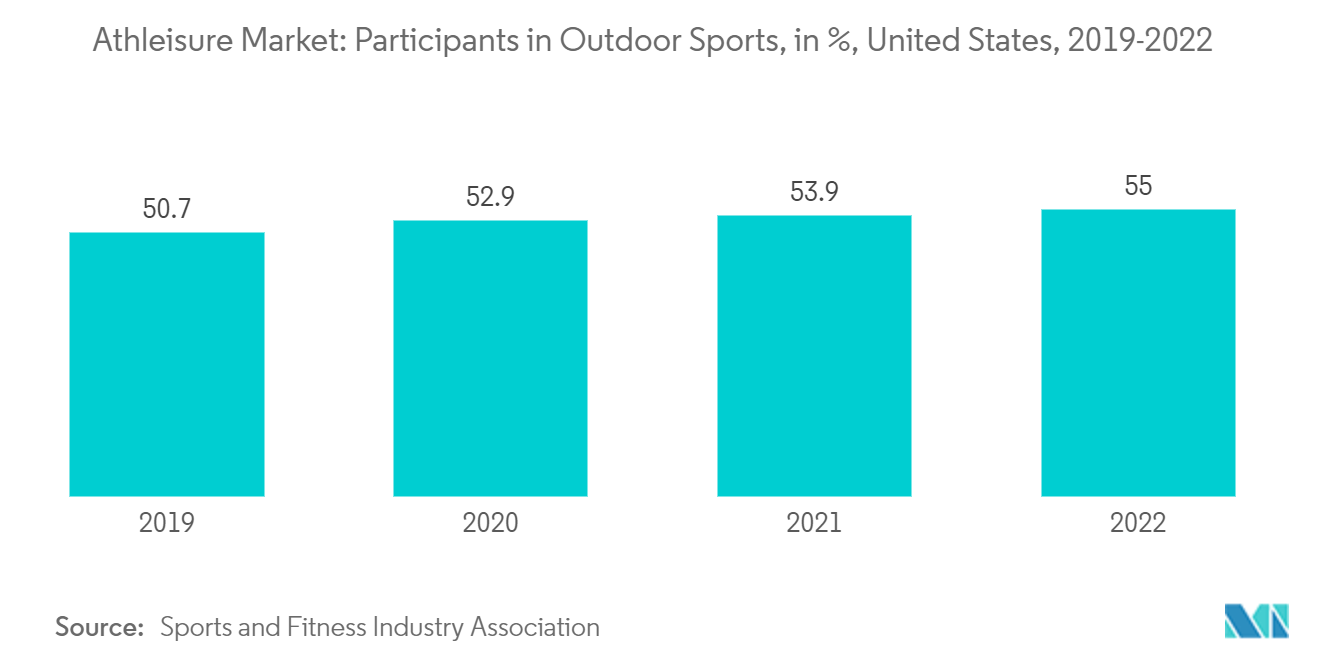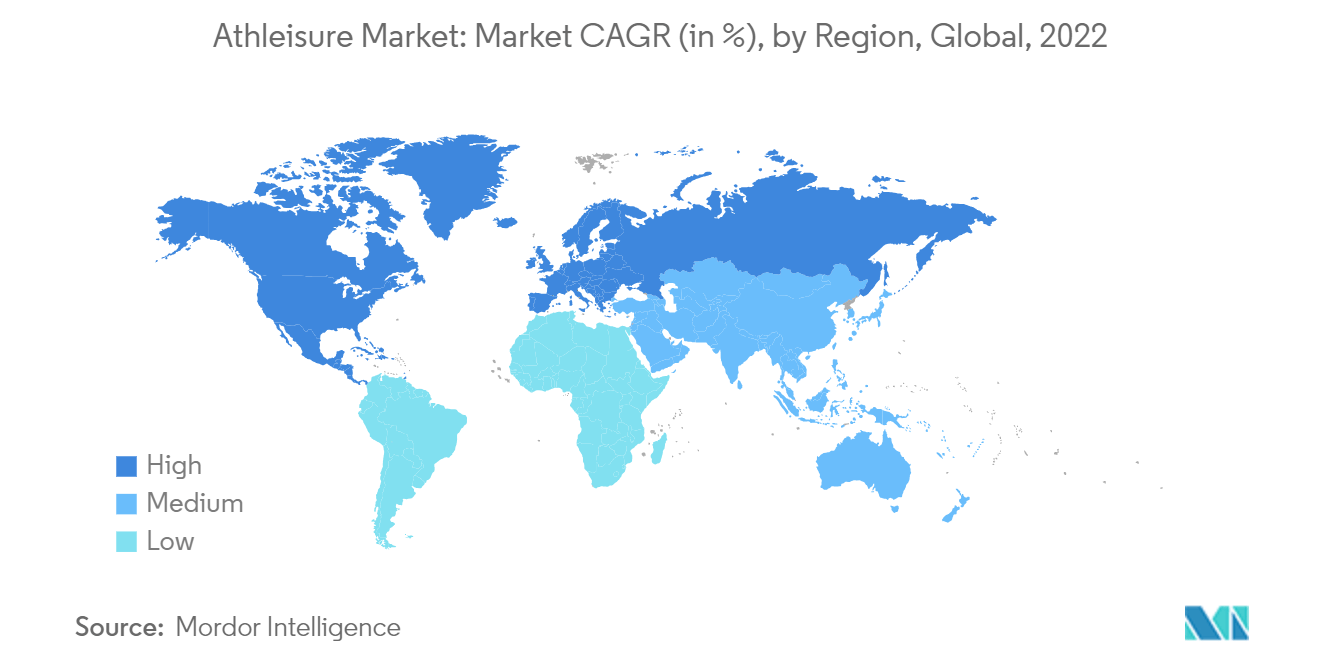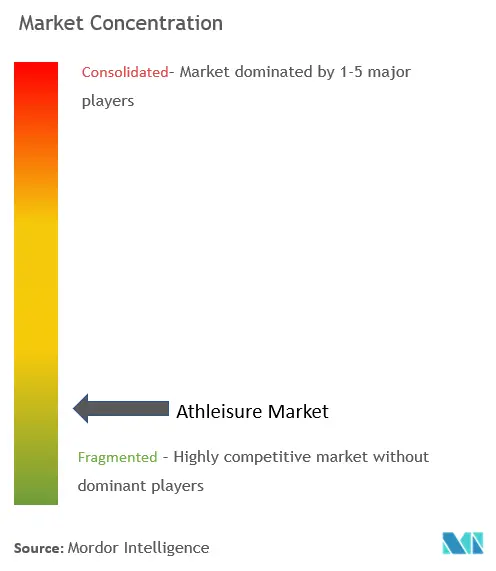Athleisure Market Size

| Study Period | 2019 - 2029 |
| Base Year For Estimation | 2023 |
| CAGR (2024 - 2029) | 6.16 % |
| Fastest Growing Market | Asia Pacific |
| Largest Market | North America |
| Market Concentration | Low |
Major Players
*Disclaimer: Major Players sorted in no particular order |
Athleisure Market Analysis
The Athleisure Market is expected to register a CAGR of 6.16% during the forecast period.
The athleisure market size is expected to grow from USD 319.10 billion in 2023 to USD 430.28 billion by 2028, at a CAGR of 6.16% during the forecast period (2023-2028).
- Rising health and self-consciousness and a desire to lead active lifestyles and appear fit are encouraging consumers to incorporate sports and fitness activities into their daily routines. This increased participation has led to a change in market dynamics, resulting in an increased demand for athleisure products.
- Additionally, the availability of sports apparel with enhanced properties such as moisture management, temperature control, and other performance-boosting characteristics that prevent discomfort and potential injury has captured the interest of consumers who are willing to pay more for such additional benefits.
- For instance, Nike claims that its Dri-FIT fabric used in its sports apparel products supports the body's natural cooling system by wicking away sweat and dispersing it across the fabric's surface to evaporate faster. Hence, these enhanced features in athleisure products have propelled consumer habits to wear athletic apparel while performing athleisure activities.
- The primary strategies adopted by the top companies operating in the market studied are product innovation and partnership. Both strategies are effective in parallel, as players generally collaborate with other companies and well-known personalities to launch their new products. For instance, in March 2022, Abercrombie & Fitch, a leading American apparel company, announced the launch of a new activewear sub-brand named YPB stands for Your Personal Best. The brand aims to empower customers to use the brand for a variety of activities, including running, stretching, lifting, and reclining.
- Moreover, an increase in government initiatives in various countries to improve sports participation played a key role in driving the demand for athleisure in the last few years. For instance, in November 2021, the government of England recommended launching a 'Work Out to Help Out' campaign to incentivize people to get involved in organized sports.
- Similarly, in August 2023, the United Kingdom government announced that it will join forces with former sports stars, health professionals, and fitness experts to help an additional 3.5 million adults and children get physically active by 2030 as part of a major national activity drive. However, the strong presence of counterfeit goods in the marketplace has become a significant threat to brand manufacturers and the market's growth. The growth of the luxury athleisure market has been affected by the presence of various counterfeit products, which may be difficult to identify as fake.
Athleisure Market Trends
Increased Sports Participation and Flourishing Demand for Sports Apparel
- The increasing popularity of fitness activities, such as aerobics, running, weight training, and yoga, along with an increase in the number of women participating in fitness and sports-related activities and surging memberships in gym and health clubs, is driving the demand for athleisure products.
- Influenced by health and wellness trends, a growing number of consumers around the world have been engaging themselves in at-home and outdoor physical activities to improve health and well-being. This factor has propelled the demand for sports apparel, which is usually made from highly absorbent material and provides comfort.
- For instance, In April 2022, the Australian Government funded USD 4.4 million for Cricket Australia and the ICC Men's T20 World Cup 2022 local organizing committee to support the legacy objectives of the T20 World Cup and enrich Australian cricket's vision of being a sport for all. Similarly, as per the survey conducted in association with Japan Sports Agency in November 2021, in Japan, 15.1% of respondents in their twenties stated that they used fitness clubs.
- Moreover, celebrity endorsements, international sporting events, social media influence, and government initiatives and campaigns such as #FitIndia (by the Government of India) have been encouraging consumers to participate in fitness and sports activities, leading to more spending on athleisure products across the world.
- For instance, in March 2022, it was revealed that the Government of Australia has plans to invest AUD 10.7 million in major sporting events, such as the ICC T20 Men's World Cup 2022 and the FIFA Women's Football World Cup 2023, among other events, to drive increased community engagement, gender equality, and physical activity participation to maximize social, economic and sporting outcomes. Such factors, coupled with raising consumers' interest in sports participation, are expected to boost the market's growth during the forecast period.

Asia-Pacific is the Fastest-growing Market
- The growing health awareness among the emerging middle class and the increasing sporting environment in countries such as China, India, Australia, and Japan are anticipated to boost the demand for athleisure products in the region during the forecast period. The athleisure market in Asia-Pacific has traditionally been dominated by major international brands such as Reebok, Adidas, Nike, Puma, and Lotto. The players in the market use various strategies like launching ad campaigns and using new technologies to innovate products to remain active in the market and increase their brand visibility and image.
- For example, in September 2021, Adidas Australia launched a ''4DFWD'' 3D printed running shoe. The 4DFWD shoe has been created using printing to create an e-midsole lattice structure that redirects vertical impact forces into horizontal forward motion. The shoes were made available through online and in offline Adidas stores across the country. Such strategic moves from major players, coupled with their aggressive promotional activities, are attracting consumers to consider athleisure wear while performing sports or fitness activities.
- Moreover, the combination of casual and athletic designs has led to a growing demand for sports apparel that can be worn casually. This 'athleisure' trend has led a growing number of consumers to seek out sports apparel, such as sneakers, yoga pants, joggers, track pants, tank tops, sports bras, and hoodies, for casual wear. Furthermore, increased consumer spending on fitness apparel as a fashion statement contributes to the appeal of sportswear in this region. Furthermore, many domestic brands such as Mizuno, Asics, HRX, and Sfida have also registered significant market penetration by constantly introducing different types of athletic wear, including clothing, footwear, and accessories, across e-commerce platforms. Such factors are expected to boost the market's growth during the forecast period.

Athleisure Industry Overview
The athleisure market is highly competitive and fragmented. Major market players are focusing on developing a diversified product portfolio, which is intensifying the competition in the market. The most active companies in the market include Nike Inc., Adidas AG, Puma SE, Under Armour Inc., and Lululemon Athletica Inc. These companies have been taking significant measures to increase their market penetration across the world with product innovations, the establishment of new bases, setting up more production plants, and associated R&D centers. These players are also active on social media platforms to advertise their athleisure products to attract more consumers worldwide.
Athleisure Market Leaders
-
Nike Inc.
-
Adidas AG
-
Lululemon Athletic
-
Puma SE
-
Under Armour Inc.
*Disclaimer: Major Players sorted in no particular order

Athleisure Market News
- August 2022: Adidas unveiled a new sportswear capsule collection. The new capsule collection features versatile pieces with minimalist aesthetics that are comfortable and can be worn throughout the day, and several are crafted partially from recycled materials. Some of the pieces include a women's rib dress, a men's classic tee paired with woven pants and a coach jacket, and a women's oversized hoodie with a rib crop top and biker shorts, among others.
- May 2022: Under Armour announced its plan to develop a direct-to-consumer platform, UnderArmour.com, after hiring Underdog Athletics as its local distributor and master franchisee in India shortly.
- February 2022: New Balance partnered with Myntra India. The company's products were made available on the platform for retailing in India. With this association, New Balance will sell a range of products on Myntra across footwear, apparel, bags, and sports accessories. The company announced its plans to start with more than 50 stock-keeping units (SKUs) and raise that number to more than 100 in the following months.
Athleisure Market Report - Table of Contents
1. INTRODUCTION
- 1.1 Study Assumptions and Market Definition
- 1.2 Scope of the Study
2. RESEARCH METHODOLOGY
3. EXECUTIVE SUMMARY
4. MARKET DYNAMICS
-
4.1 Market Drivers
- 4.1.1 Increased Sports Participation and Flourishing Demand for Sports Apparel
- 4.1.2 Rising Innovation in Athleisure Products
-
4.2 Market Restraints
- 4.2.1 Penetration of Counterfeit Products
-
4.3 Industry Attractiveness - Porter's Five Forces Analysis
- 4.3.1 Threat of New Entrants
- 4.3.2 Bargaining Power of Buyers/Consumers
- 4.3.3 Bargaining Power of Suppliers
- 4.3.4 Threat of Substitute Products
- 4.3.5 Intensity of Competitive Rivalry
5. MARKET SEGMENTATION
-
5.1 Product Type
- 5.1.1 Clothing
- 5.1.2 Footwear
- 5.1.3 Other Product Types
-
5.2 End User
- 5.2.1 Men
- 5.2.2 Women
- 5.2.3 Kids
-
5.3 Distribution Channel
- 5.3.1 Offline Retail Stores
- 5.3.2 Online Retail Stores
-
5.4 Geography
- 5.4.1 North America
- 5.4.1.1 United States
- 5.4.1.2 Canada
- 5.4.1.3 Mexico
- 5.4.1.4 Rest of North America
- 5.4.2 Europe
- 5.4.2.1 United Kingdom
- 5.4.2.2 Germany
- 5.4.2.3 Spain
- 5.4.2.4 France
- 5.4.2.5 Italy
- 5.4.2.6 Russia
- 5.4.2.7 Rest of Europe
- 5.4.3 Asia-Pacific
- 5.4.3.1 China
- 5.4.3.2 Japan
- 5.4.3.3 India
- 5.4.3.4 Australia
- 5.4.3.5 Rest of Asia-Pacific
- 5.4.4 South America
- 5.4.4.1 Brazil
- 5.4.4.2 Argentina
- 5.4.4.3 Rest of South America
- 5.4.5 Middle-East and Africa
- 5.4.5.1 United Arab Emirates
- 5.4.5.2 South Africa
- 5.4.5.3 Rest of Middle-East and Africa
6. COMPETITIVE LANDSCAPE
- 6.1 Strategies Adopted By Leading Players
- 6.2 Market Share Analysis
-
6.3 Company Profiles
- 6.3.1 Adidas AG
- 6.3.2 Nike Inc.
- 6.3.3 Under Armour Inc.
- 6.3.4 New Balance Athletics Inc.
- 6.3.5 Columbia Sportswear Company
- 6.3.6 ASICS Corporation
- 6.3.7 Puma SE
- 6.3.8 VF Corporation
- 6.3.9 Wolverine Worldwide Inc.
- 6.3.10 Lululemon Athletica Inc.
- *List Not Exhaustive
7. MARKET OPPORTUNITIES AND FUTURE TRENDS
** Subject To AvailablityAthleisure Industry Segmentation
Athleisure includes a range of clothing, footwear, and accessories used in athletics and leisure activities.
The athleisure market is segmented based on product type, end-user, distribution channel, and geography. By product type, the market is segmented into clothing, footwear, and other product types, including caps, headbands, wristbands, elbow bands, and socks. By end user, the market is segmented into men, women, and kids. The market is segmented by distribution channel into offline retail stores and online retail stores. The report also provides an analysis of the emerging and established economies across the worldwide market, including regions like North America, Europe, Asia-Pacific, South America, and the Middle East and Africa.
The market sizing has been done in value terms in USD for all the abovementioned segments.
| Product Type | Clothing | |
| Footwear | ||
| Other Product Types | ||
| End User | Men | |
| Women | ||
| Kids | ||
| Distribution Channel | Offline Retail Stores | |
| Online Retail Stores | ||
| Geography | North America | United States |
| Canada | ||
| Mexico | ||
| Rest of North America | ||
| Geography | Europe | United Kingdom |
| Germany | ||
| Spain | ||
| France | ||
| Italy | ||
| Russia | ||
| Rest of Europe | ||
| Geography | Asia-Pacific | China |
| Japan | ||
| India | ||
| Australia | ||
| Rest of Asia-Pacific | ||
| Geography | South America | Brazil |
| Argentina | ||
| Rest of South America | ||
| Geography | Middle-East and Africa | United Arab Emirates |
| South Africa | ||
| Rest of Middle-East and Africa |
Athleisure Market Research FAQs
What is the current Athleisure Market size?
The Athleisure Market is projected to register a CAGR of 6.16% during the forecast period (2024-2029)
Who are the key players in Athleisure Market?
Nike Inc., Adidas AG, Lululemon Athletic, Puma SE and Under Armour Inc. are the major companies operating in the Athleisure Market.
Which is the fastest growing region in Athleisure Market?
Asia Pacific is estimated to grow at the highest CAGR over the forecast period (2024-2029).
Which region has the biggest share in Athleisure Market?
In 2024, the North America accounts for the largest market share in Athleisure Market.
What years does this Athleisure Market cover?
The report covers the Athleisure Market historical market size for years: 2019, 2020, 2021, 2022 and 2023. The report also forecasts the Athleisure Market size for years: 2024, 2025, 2026, 2027, 2028 and 2029.
What are the key growth drivers for athleisure in emerging markets?
The key growth drivers for athleisure in emerging markets are a) Growing popularity of sports and fitness activities creates a need for functional and fashionable athleisure options b) E-commerce platforms expand access to athleisure brands, catering to convenience-seeking consumers in emerging markets
What are the sustainability challenges in the Athleisure Industry?
The sustainability challenges in the Athleisure Industry are a) Lack of robust recycling and reuse systems for used athleisure garments b) Ethical sourcing concerns regarding labor practices and transparency
Athleisure Industry Report
The global athleisure market, a sector of the fashion and apparel industry, is witnessing significant growth due to the rise in health and wellness trends worldwide. This market includes clothing designed for both athletic activity and relaxed, everyday use, blurring the lines between traditional sportswear and casual attire. It appeals to fashion-conscious customers, fitness enthusiasts, and those seeking comfortable, utilitarian clothing for everyday activities. The market is segmented by gender, product type, distribution channel, and region. The surge in fitness activities and the fusion of exercise and fashion have increased the demand for athleisure products, especially among the female and elderly consumer segments. The trend of wearing athleisure wear in various social environments, including workplaces, has further contributed to market growth. Key market drivers include the rise in health and wellness trends, changing lifestyle preferences, and the fusion of exercise and fashion. Mordor Intelligence™ Industry Reports provide statistics for Athleisure market share, size, and revenue growth rate, along with a market forecast outlook and a historical overview. A sample of this industry analysis is available as a PDF download.



